Electric trucks have shorter spec’ sheets, but there’s still plenty to consider
North American truckers have enjoyed a decades-long love affair with their spec’ sheets. At one time, everything from wheel seals to brake linings, U-joints, and pinion gears were on the table. One former OEM CEO told me in private that his company offered more than 50 different options for placing an interior overhead cab light. That’s no longer the case, but it illustrates North American fleets take vehicle spec’ing seriously.
As OEMs add electric trucks to their product portfolios, fleets will find somewhat fewer powertrain options when compared to diesel-powered equipment.
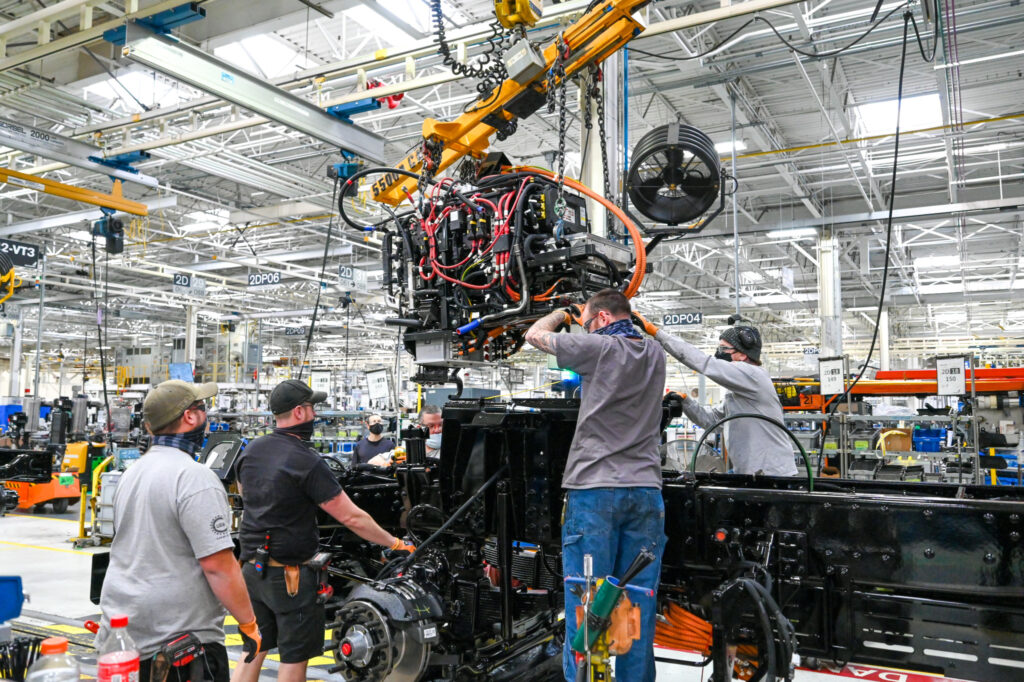
Don’t panic. Fewer options won’t mean fewer opportunities to customize vehicle spec’s for an application. Electric motors, with their super-wide powerband, reduce or nearly eliminate the need to precisely match engine speed to road speed through myriad gear ratios.
With the exception of some unique circumstances, common e-powertrain configurations will meet the needs of most fleets in most applications.
“Customization is a delicate balance, especially when adopting new technology such as electromobility,” says Andy Brown, product manager at Volvo Trucks North America. “We’ve attempted to make this adoption as seamless as possible.”
Volvo and other OEMs have been developing and learning as the powertrains evolve, and those learnings are integrated into subsequent vehicle generations. It’s safe to say the industry is still on the up side of the learning curve, but it’s already evident that electric powertrains will be physically less complex than those on traditional chassis, with less demand for direct input from the customer.
Customers will have more to contribute to the spec’ in terms of the desired battery capacity related to vehicle range and the types of charging and controls systems on board. Each will directly affect the truck’s operation and application, and need to be considered. As will options like aero fittings and lightweight components aimed at reducing energy demand and reducing chassis weight to make room for batteries and improve vehicle range.
A primer on electric motors
Like diesel engines, electric motors have “sweet spots” for efficiency and power output. But unlike diesels, electric motors produce torque over a much broader motor speed range, and they have larger efficiency ranges. Electric motors produce maximum torque from practically 1 rpm all the way out to 2,000 or 3,000 rpm or higher, depending on the motor design. At some point in the rpm range the torque begins to drop off and the motor comes into its most energy-efficient range. On the chart below, theoretical peak efficiency is shown at about 4,000 rpm and between 100 and 300 Nm of torque.
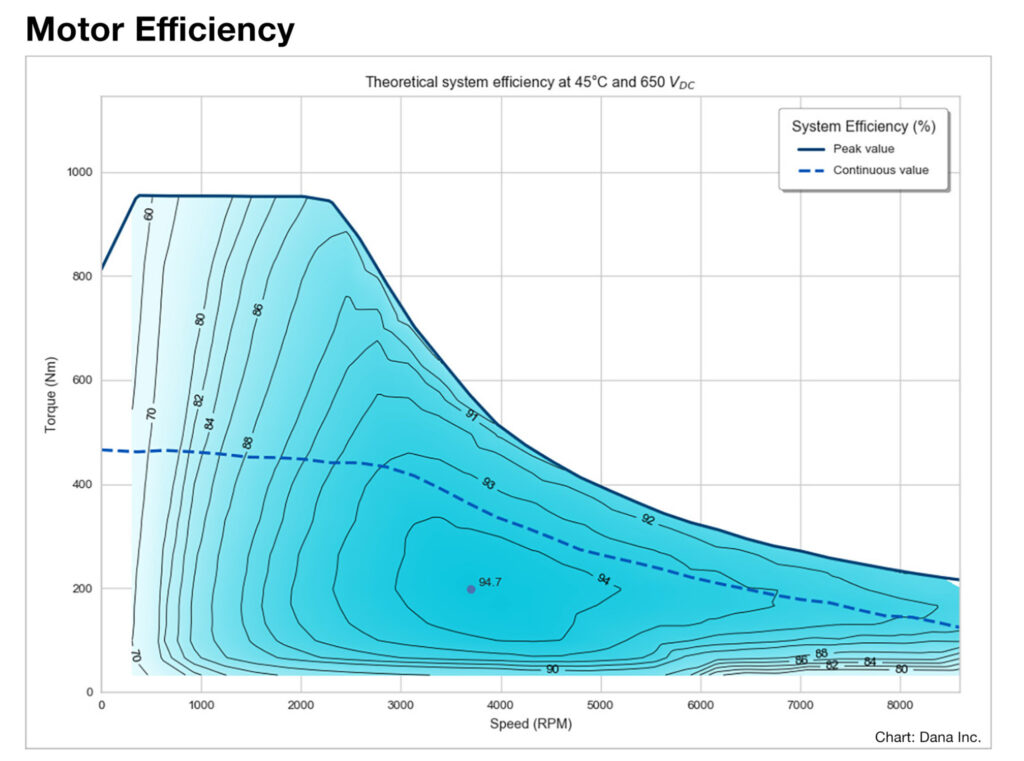
The goal with a motor spec’ would be to stay within or close to that efficiency range through most of the vehicle’s operating range. Like a diesel, most of the torque lives in the lower side of the operating range, but unlike diesels, electric motors use energy more efficiently at higher shaft speeds. Consequently, high rpm is your friend with an electric motor.
“[Peak efficiency] for the motor ends up being a fairly decent size, but it can’t cover everything for a single speed application,” explains Jeremy Frenznick, senior director of commercial vehicle engineering at Dana. “You’re have that ramp-up into that speed, and you have the overspeed when you get beyond it. By using additional gears, you can run up through it again and you can run through it a third time until you sit there at cruise speed in that high-efficiency area. By targeting with appropriate rear-axle ratios, or secondary reductions in a transmission or an E-axle, we can keep that motor in its most efficient state for more of the duty cycle.”
Depending on the application, vehicle weight, operating profiles and intended road speeds, some electric trucks will have no transmissions, relying on the real-axle gear ratios to provide things like suitable startability and gradeability. Heavier trucks and those operating at higher road speeds will, along with the rear-axle ratios for the application, use two- or perhaps three-speed transmissions to compensate for the varying duty cycles.
“Combustion engines use advanced transmissions and gear ratios to allow for startability, gradeability, and efficient top speeds in multiple applications. Whereas, in general, eMotors have the advantage of operating efficiently at a wider rpm range than combustion engines,” says Alexander Voets, Daimler Truck’s eMobility product marketing and sales strategy manager. “eMotors, on the other hand, do not require similar torque conversions as electric motors have instant torque and acceleration by design.”
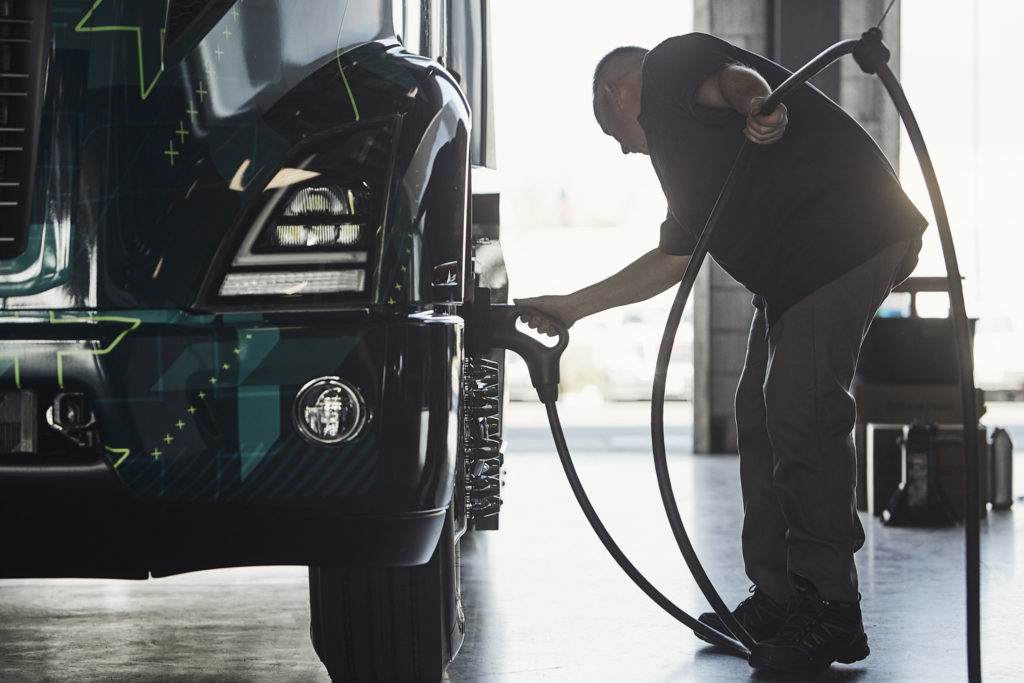
Transmissions and OEM strategy
Those are the basics. It’s likely to get more complicated when you start comparing brands side by side. The motor’s operating speed isn’t something the customer needs to worry about. OEMs focus on a host of other factors within the vehicle’s electrical and mechanical architecture to provide the necessary range and operating efficiency. These will no doubt vary from truckmaker to truckmaker, and even across the different makes and models of motors.
For example, in a product walkaround video on YouTube, Volvo Trucks senior product manager for electric vehicles John Moore says the peak torque for the OEM’s motor package is from zero to 3,500 rpm, and peak horsepower is from 4,000 to 9,500 rpm. “And that efficiency range is the sweet spot between 3,000 and 9,000 rpm,” he notes.
With a broad operating range like that, Volvo can use a two-speed I-Shift transmission that shifts at 30-40 km/h. Other manufacturers use single-, two-, or three-speed gear reduction technologies or transmissions to address performance needs like startability, gradeability, and top vehicle speed.
“Because of the broad range of peak output and efficiency with electric motors, you don’t need 10, 12, or 13 speeds to stay in the sweet spot,” says Rodrigo Soffner, senior director of global ePowertrain and smart systems at Meritor. “The transmission is another lever we can pull and plug into our system to create configurability.”
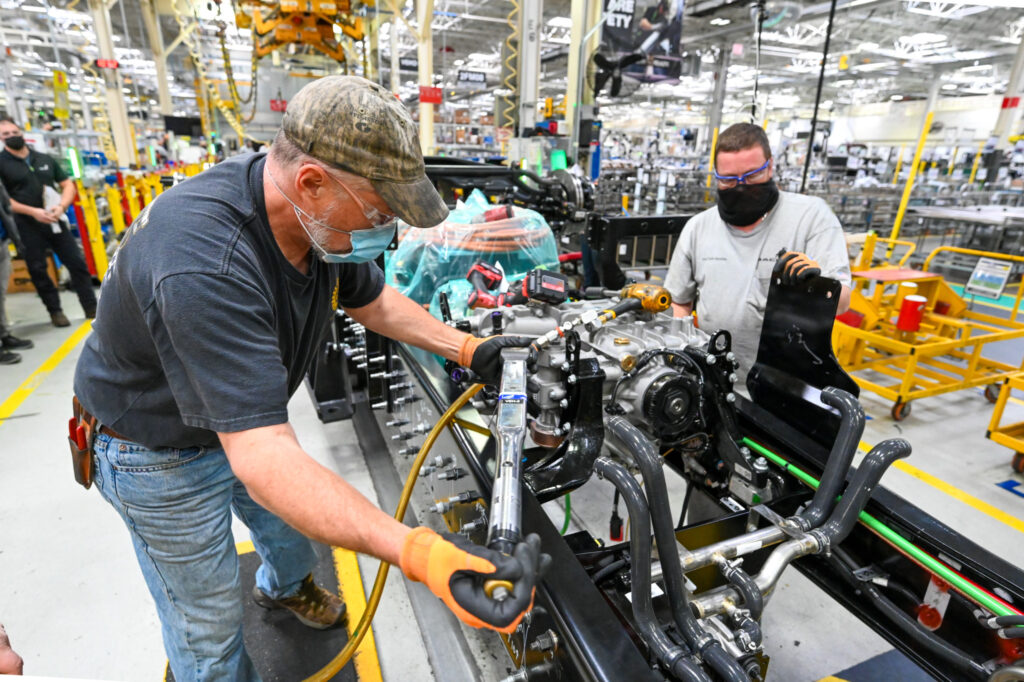
Integrated, traditional, or eAxle
Because electric motors are so small compared to an internal combustion engine, they can be located in different and non-traditional places on the chassis. Some truckmakers continue to mount the motor under or just behind the cab, using a traditional driveshaft to get the torque to the drive axle. Other are integrating the motors directly onto or into the drive axle, usually at the front of the axle housing where one would expect top find the driveshaft input.
In other instances, the motor is transverse-mounted in line with the axle, creating a smaller profile and eliminating the traditional differential gears.
Buyers may select the exact motor and axle configuration in some cases, but the configuration will depend more on vehicle characteristics like intended gross vehicle weight and road speed.
“These systems are pretty complex, and they’re based on top-level vehicle level requirements,” notes Frenznick. “There’s far less opportunity to do the cherry picking that we’ve become accustomed to. Things like motors and inverters, gearboxes, whether it’s e-transmission or e-axles, actuators, controllers, they all need to communicate with each other over the course of the vehicle lifetime. And this only happens by doing that top-level-down development.”
There will of course be tradeoffs in using one axle configuration or another. Suspension interfaces, for example, would be different. There could also be some cost considerations in opting for one suspension over another, or in the choice of brakes like discs or drums. In any case, there will almost certainly be some cost savings in using a traditional axle housing from an engineering and chassis integration point of view.
Actual drive axle configurations may come down to a choice of OEM, as various builders will favor one system over another. Some may ultimately offer both, but the choice will probably not be yours alone.
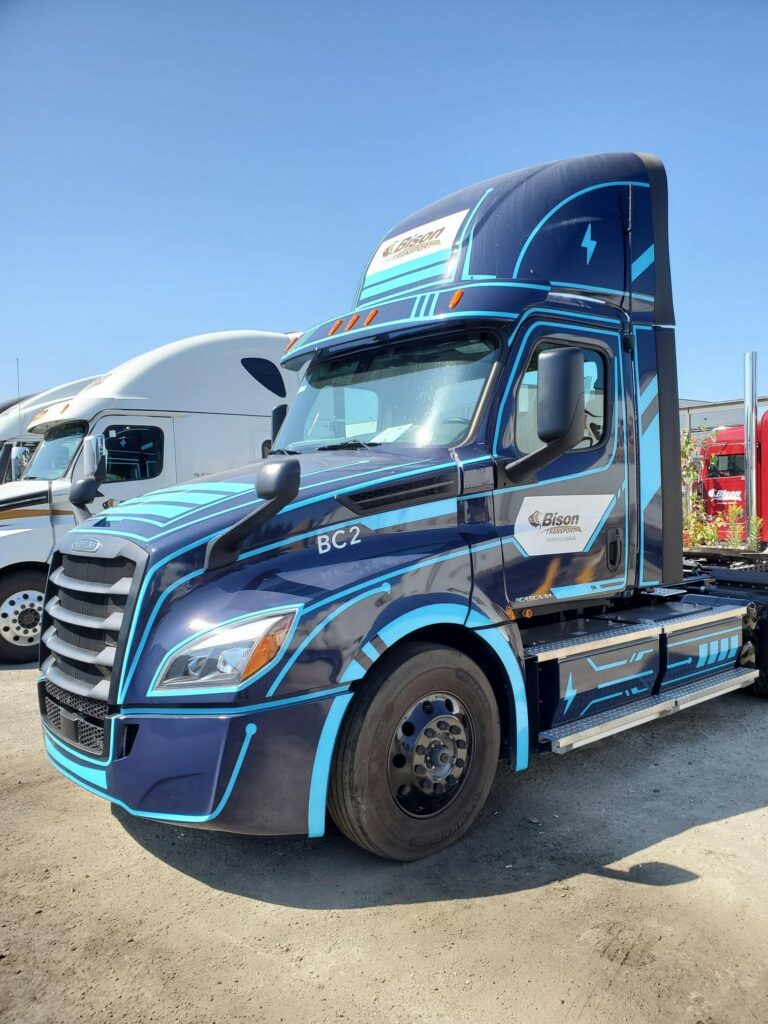
Customer spec’ing options
While almost every powertrain-related component on the truck will be engineered and optimized for efficiency, performance and durability, batteries and charging infrastructure can be customized. All the OEMs offer several different options, as there is a significant impact on price and that obviously directly impacts the operator’s ROI on electrification.
The battery spec’ is almost entirely dependent on the truck’s intended use and expected range, and is sized accordingly – with a contingency for age- and weather-related degradation. OEMs can guide battery pack choices, but there are hardly any tradeoffs here. If you want to drive X miles with X weight, you need X kilowatt/hours of battery capacity. Period.
In terms of the onboard electrical architecture, charging and converters/inverters can be spec’d to suit individual fleet requirements.
“Heavy-duty commercial favors DC charging, which doesn’t require an onboard inverter. [The battery stores energy as direct current.] However, AC charging does require on onboard inverter [called an onboard charger], which can add to cost,” says Brian Alexander, director of public relations at Lion Electric. “There are dozens of choices for chargers on the market, if not hundreds, of varying power levels. So while it’s not a component of the vehicle itself, it is a large variable in the purchase process.”
So, we’re down to the short strokes on the spec’ sheet now. Obviously, energy efficiency is key in an all-electric vehicle, so aero treatments will matter in highway trucks operating at high speeds. Maybe not so much on urban and regional trucks. Past fleet experience could provide some guidance here. If it saves fuel on a diesel truck, it will reduce energy consumption on an electric truck, too. It’s a question of how much you care to invest for the energy savings. The same thinking applies to weight-saving technologies like wide-single tires.
But with tires, bear in mind that electric motors and their massive torque output will affect tire life.
While spec’ing options for electric trucks will need to be constrained by engineering considerations, those who like to tinker with their vehicle spec’ will find plenty to keep themselves entertained — like choosing type of upholstery and the color of the truck. Or maybe cabin lighting options.
Have your say
This is a moderated forum. Comments will no longer be published unless they are accompanied by a first and last name and a verifiable email address. (Today's Trucking will not publish or share the email address.) Profane language and content deemed to be libelous, racist, or threatening in nature will not be published under any circumstances.